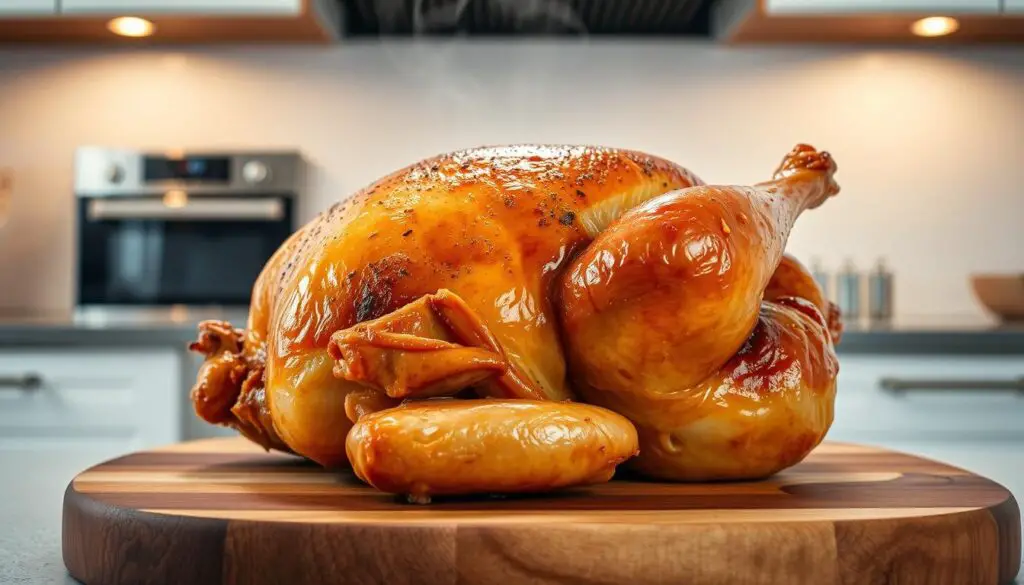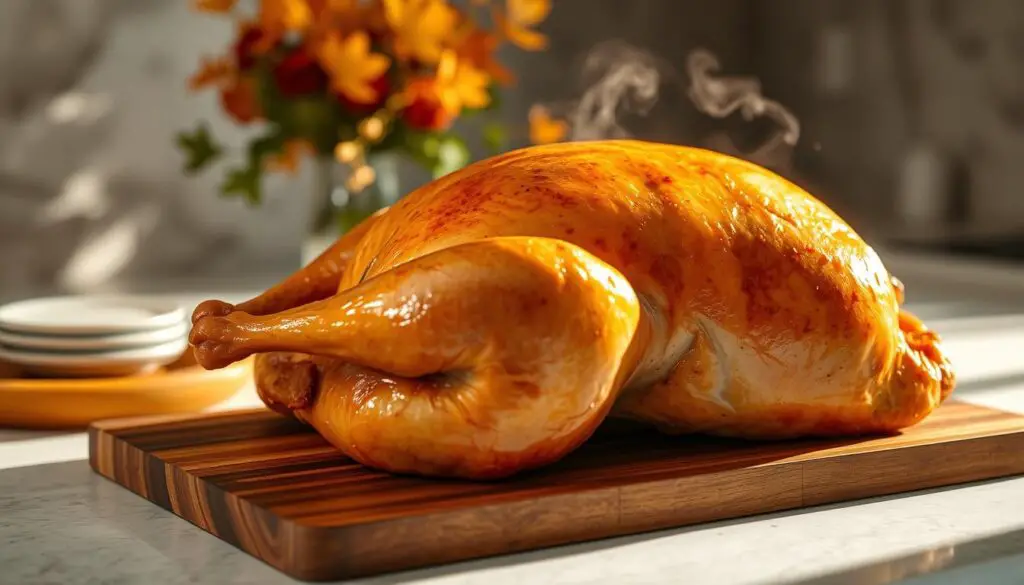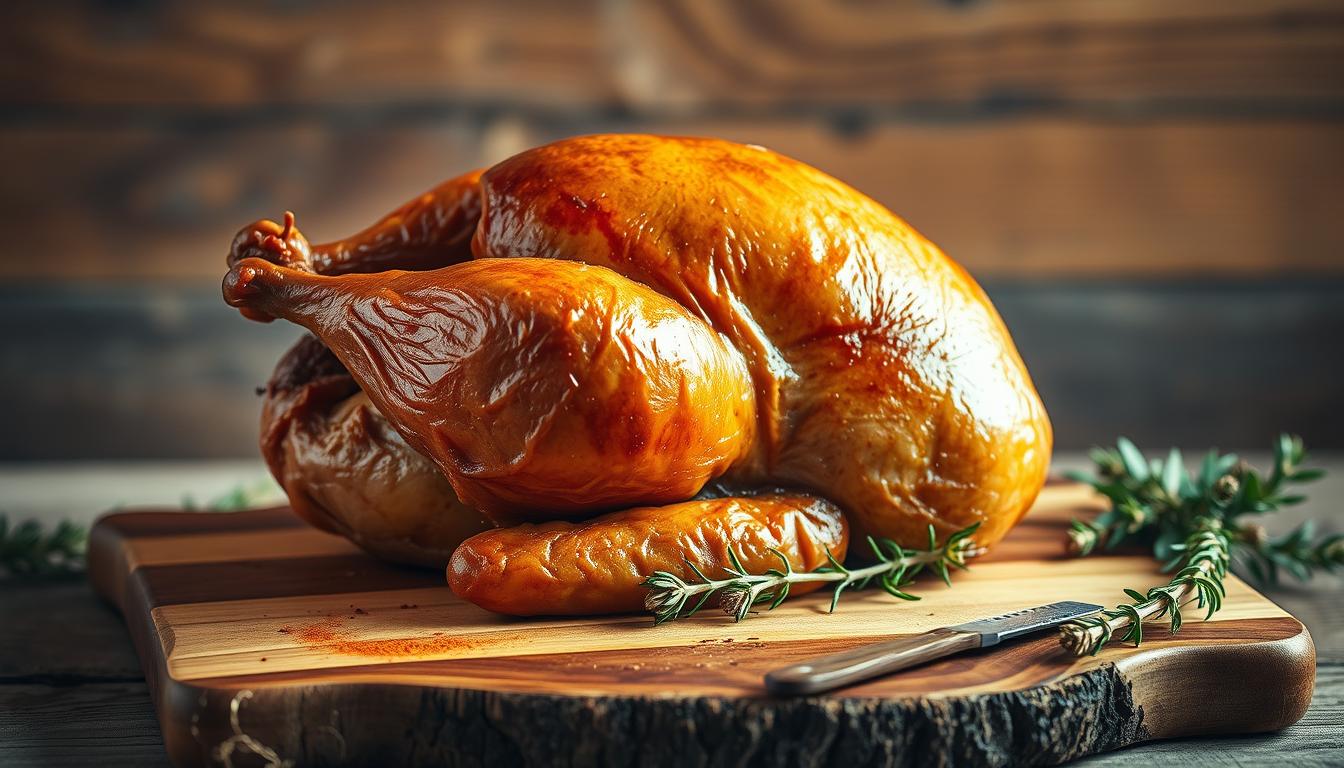Imagine the golden-brown roast turkey at your Thanksgiving table. It’s not just a dream—it’s achievable. For years, my family has tested my cooking skills with the Thanksgiving turkey. Now, I’m ready to share the secrets to a juicy, flavorful bird.
Forget the stress of guessing temperatures or timing. This recipe cooks a 12-pound turkey in under 3 hours. It includes a 45-minute rest after cooking. Each bite is packed with 103g of protein and has crisp, crackling skin.
No more last-minute panics. This guide helps whether you’re feeding 12 guests or just a few. It covers thawing, seasoning, and roasting in simple steps. Start with a buttery herb rub to boost flavor without extra effort. Your Thanksgiving turkey will shine with this guide.
Why Roast Turkey is the Star of Thanksgiving
Imagine the excitement when you show off your golden-brown turkey. That’s when your Holiday Feast truly comes alive. But why is this bird so crucial to your celebration?
The Tradition of Thanksgiving Turkey
At first, venison was the star of the 1621 harvest meal. But turkey’s popularity grew in the 1800s. Poultry producers marketed it as the perfect centerpiece for the Holiday Feast. By the late 1800s, turkey became a must-have at Thanksgiving.
Key moments include:
- 1863: Abraham Lincoln’s Thanksgiving proclamation
- 1880s: Poultry ads highlighted turkey’s “holiday perfection”
- Modern tradition: 90% of Americans serve it yearly
Nutritional Benefits of Turkey
Your Turkey Dinner is not just tasty but also healthy. It beats other meats in several ways:
| Nutrient | Per 3-oz serving |
|---|---|
| Protein | 26g |
| Saturated fat | 3g |
| Vitamins B6/B12 | Natural source |
Why Choose Roast Turkey Over Other Options
When planning your Holiday Feast, turkey stands out for many reasons:
Practicality: One turkey can feed 16 guests easily
Showstopping: Its crispy skin and juicy meat make it a table-ready masterpiece
Flavor flexibility: You can season it with herbs, gravy, or brine to suit your taste
From its rich history to its crowd-pleasing appeal, roast turkey is the top choice for a memorable Thanksgiving.
Selecting the Right Turkey for Your Feast
Finding the perfect turkey is key to a great Turkey Recipe. The freshness and size of the turkey affect both taste and how much food you’ll have.
Fresh vs. Frozen Turkey
Choosing between fresh and frozen turkeys depends on timing and budget. Fresh turkeys are ready to cook right away but cost more. Frozen turkeys are cheaper but need 24 hours of thawing per 4 lbs in the fridge. With the right cooking methods, both can be delicious.
Ideal Size for Your Gathering
Here’s how to pick the right turkey size to avoid too little or too much:
- Under 8 guests: 10–12 lbs (saves money vs. smaller birds)
- 8 guests: 10–12 lbs (plenty for second helpings)
- 12 guests: 14–18 lbs (crowd-pleasing portions)
- 16+ guests: Two turkeys (18–24 lbs each) cook evenly and faster than one big bird
Organic and Free-Range Options
For a richer flavor, look into Organic Valley or Nature’s Catch turkeys. These birds have better muscle movement and varied diets. They’re pricier but add a special touch to your Turkey Recipe.
Essential Ingredients for a Delicious Roast Turkey
Creating the perfect Roast Turkey starts with the right ingredients. These basics ensure your turkey is juicy, tender, and packed with flavor. Let’s break down what you need to succeed.
Basic Ingredients You Can’t Skip
High-quality unsalted butter is a must. Use 5 tablespoons for a 12-pound turkey—mix it with salt, pepper, and lemon zest for a simple rub. Garlic, onion, and lemon wedges inside the cavity add moisture and savory notes. Salt and pepper balance everything, while herbs like rosemary and thyme elevate the dish.
Herbs and Spices for Flavor
- Use fresh rosemary, thyme, and sage—dried herbs lack the brightness of fresh.
- Combine butter with minced garlic, lemon zest, and herbs to make a flavorful herb butter.
- Bay leaves and peppercorns add subtle depth when simmered in the brine.
Preparing the Perfect Brine
A brine gives extra moisture. Mix 1/2 cup salt, 1/2 cup brown sugar, peppercorns, and bay leaves in water. Soak your turkey for 24 hours per 4-5 pounds in the fridge. This step is optional but makes a big difference!
Preparing Your Turkey: Clean and Stuff
Learning the basics of Turkey Cooking Tips begins with proper preparation. Follow these steps to make sure your bird is oven-ready. This way, you avoid safety risks and keep the flavor intact.
- Thaw your turkey in the fridge, allowing 24 hours per 5 pounds. A 15-pound turkey needs 3 days. Never leave it on the counter—bacteria thrive in the USDA’s “Danger Zone” (40°F–140°F).
- Remove giblets and neck from the cavity. Rinse is a myth: the USDA warns against washing poultry as it spreads germs. Pat the turkey dry with paper towels to crisp skin later.
Stuffing? Cook it separately for safety. Fill the cavity with onion, lemon, or herbs for flavor. If you must stuff the turkey, check the center reaches 165°F with a thermometer.
- Never thaw at room temperature longer than 1 hour.
- Use kitchen twine to tie legs for even cooking.
- Discard the store-bought neck and giblet packet before roasting.
These Turkey Cooking Tips ensure a safe, juicy turkey. Proper prep keeps guests safe and your kitchen clean—no messy rinsing needed!
Seasoning and Marinades: Get Creative!
Seasoning is the secret to making your Thanksgiving Turkey a hit. Whether you choose classic flavors or bold new ones, these tips will make every bite unforgettable.
Begin with a classic herb butter that melts into the meat. Mix softened butter with minced garlic, rosemary, thyme, salt, and pepper. Spread a third of the butter under the skin of the breast. Then, coat the outside with the rest. This adds moisture and rich flavor.
Pro tip: Prep the herb butter the night before. This lets the flavors meld together.
| MARINADE | INGREDIENTS | METHOD |
|---|---|---|
| Citrus-Herb | Orange zest, thyme, rosemary, olive oil | Marinate 12-24 hours for bright citrus notes |
| Maple-Bourbon | Bourbon, maple syrup, smoked paprika | Brush on before roasting for a sweet-smoky finish |
| Smoky-Paprika | Paprika, cayenne, garlic paste | Rub under and over skin 1 hour pre-roast |
Timing is key: Apply marinades 1-24 hours before roasting. For herb butter, let it sit on the turkey overnight in the fridge. Pat the skin dry before cooking for a crispy finish. Your Thanksgiving Turkey needs bold flavors—don’t skip this step!
Roasting Techniques for Perfect Results
Mastering the oven roasting process ensures your Oven Roasted Turkey turns out golden, juicy, and full of flavor. Let’s break down the steps to avoid common mistakes.

- Preheat your oven to 325°F. This steady heat ensures even cooking without drying out the meat.
- Position the turkey breast-side up on a rack in a roasting pan. This setup promotes even browning and crispier skin.
- Cook until the thigh reaches 165°F. Use a digital thermometer to check doneness—no guesswork required.
Pro tip: Baste every 30 minutes using the fat pooling in the pan, not just broth. This step keeps the meat moist and adds rich flavor.
| Turkey Weight | Cooking Time |
|---|---|
| 10–12 lbs | 2.5–3 hours |
| 14–18 lbs | 3–3.5 hours |
| 18–22 lbs | 3.5–4 hours |
Adjust temps if your oven runs hot. If the skin browns too fast, tent loosely with foil. Let the turkey rest 30 minutes post-roast to lock in juices. Your guests will marvel at how simple steps turn a classic into a showstopper!
The Perfect Cooking Time and Temperature
Mastering cooking time and temperature is key to a moist and tender Juicy Turkey. Here’s how to get it right:
General Guidelines for Cooking Times
Follow these time ranges based on turkey weight:
| Weight | Cooking Time |
|---|---|
| 10–14 lbs | 2.5–3.5 hours |
| 15–19 lbs | 3.5–4.5 hours |
| 20–24 lbs | 4.5–5.5 hours |
Always preheat your oven to 350°F (175°C) and start timing once it reaches temperature.
Tools to Check Internal Temperature
- Use an instant-read thermometer or leave-in probe
- Check the turkey’s thickest parts: thigh and breast
- Aim for 160°F in the breast and 165°F in the thigh
Remove the turkey when the breast hits 155°F—carry-over heat will finish the job.
How to Avoid Overcooking
Check the turkey every 10 minutes once it nears target temps. Look for clear juices when pierced. If browning the breast, set it under the broiler for 4–5 minutes at 500°F once internal temps hit 150°F.
Rest the turkey for 30 minutes after removing it from the oven. This traps juices inside for maximum moisture. Remember: Juicy Turkey starts with precision, not guesswork!
Letting Your Turkey Rest: The Key to Juiciness
The final step in any Turkey Recipe is resting. Skipping this can lead to dry meat and soggy platters. Letting your turkey cool for 30 minutes ensures every bite is moist and flavorful.

Why Resting is Important
Hot meat contracts when sliced, pushing out juices. Resting allows these juices to spread evenly. This step turns a good Turkey Recipe into a memorable one—moist, tender, and full of flavor.
Recommended Resting Time
- Minimum 30 minutes for most turkeys
- Large turkeys (over 15 lbs) need 45-60 minutes
- USDA advises 20 minutes, but 30 ensures full redistribution of juices
How to Keep it Warm
Keep your turkey warm without drying it out:
- Place on a cutting board, loosely cover with foil (don’t seal it—let the steam escape)
- If holding longer than an hour, tuck it back into a 200°F oven with foil
- Avoid wrapping tightly—this keeps skin crisp while meat stays warm
Resting isn’t downtime—it’s your secret to a perfect Turkey Recipe. Enjoy this time finishing sides or setting the table. Your turkey will thank you!
Carving and Serving Your Roast Turkey
After resting your turkey for 30 minutes to an hour, it’s time to make it the star of your Turkey Dinner. You’ll need a sharp carving knife, a sturdy meat fork, and a cutting board with a groove. OXO’s ergonomic carving tools make the job easier and more precise.
Best Tools for Carving
A 9-inch carving knife cuts through meat cleanly. Use a meat fork to hold the turkey in place. A groove-edged board catches juices for extra gravy. Electric knives are good for beginners, but a sharp blade works best.
How to Carve Like a Pro
Start by removing the legs. Cut between the thigh and breast, then separate the drumsticks from thighs. For the breast, slice ½-inch thick pieces along the bone. Rotate the turkey to carve the other side. Always carve onto a warmed platter to keep the meat hot.
Presentation Tips for Your Thanksgiving Table
Arrange slices on a heated platter in separate sections for white and dark meat. Add rosemary sprigs or a citrus garnish. Serve with a gravy boat kept warm on a trivet. Save bones for stock and refrigerate leftovers within two hours. Your Turkey Dinner’s success depends on presentation—every detail matters!
FAQ
What is the best way to ensure my turkey is juicy?
To get a juicy turkey, start with a good brine. It boosts flavor and keeps moisture in. Also, take the turkey out of the oven when it’s about 160°F. It will heat up more as it rests, reaching the safe 165°F.
How long should I thaw a frozen turkey?
Thaw your turkey in the fridge, taking about 24 hours for every 5 pounds. A 15-pound turkey needs three days. If you’re in a hurry, thaw it in cold water, changing the water every 30 minutes. This method thaws about 30 minutes per pound.
Can I stuff my turkey?
Yes, you can stuff your turkey, but it’s safer to cook stuffing in a dish. This way, the stuffing gets hot enough without overcooking the turkey. If stuffing it, use a thermometer to ensure the stuffing hits 165°F.
What herbs work best for seasoning my roast turkey?
For a great roast turkey, use fresh herbs like rosemary, thyme, and sage. They give a classic Thanksgiving smell and taste. Garlic and onion add depth, and a lemon keeps the meat moist.
What’s the best temperature to roast my turkey?
The best roasting temperature for a turkey is 325°F. This heat cooks the turkey evenly and makes the skin golden. Some start hot for color then lower it, but 325°F is more reliable.
How can I make sure the skin is crispy?
To get crispy skin, dry the turkey well before roasting. Apply herb butter under the skin. Baste the turkey every 30 minutes to get that golden, crispy skin.
How long do I need to let the turkey rest after cooking?
Let your turkey rest for at least 30 minutes, but 45 minutes to an hour is better. This lets the juices spread, making the turkey juicier and tastier.
What can I do with leftover turkey?
Leftover turkey is great for many dishes! Try turkey sandwiches, soup, or casseroles. You can also make a rich turkey stock from the carcass for future meals.
